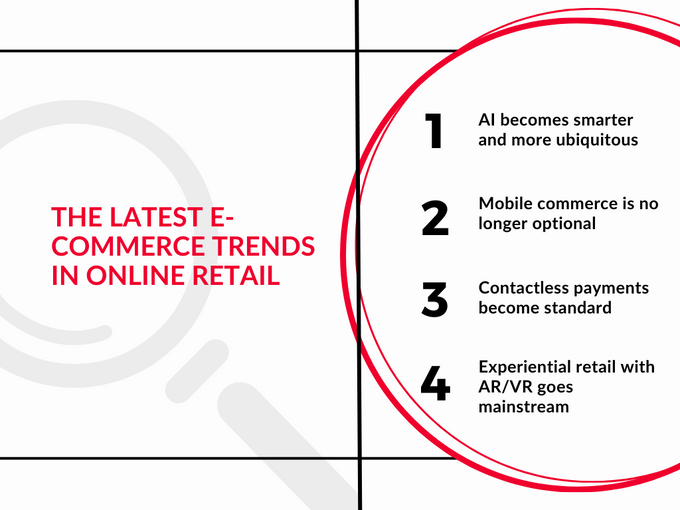eCommerce Trends: Exploring the Latest Innovations in Online Retail
With so many advancements in the age of AI, let's take a look at the eCommerce trends you need to know.
Updated November 19, 2024.

As a Shopify store owner, I believe it's essential to keep up with the latest technologies and strategies that can help you improve your operations and customer experience. Trends matter: last year, Fast Simon predicted that using personalization would be a key differentiator for any eCommerce store that wants to stand out. This remains true today.
By monitoring trends, you can enhance your own store operations and tap into new opportunities for growth. Most importantly, you can remain relevant in a highly competitive market. Let's get right into the four eCommerce trends to know for the year ahead.
» Want to offer your customers what they want? Learn all about predictive personalization
Meet the Expert
Jameela Ghann is a seasoned online store owner with over a decade of eCommerce experience. Apart from running Alora Boutique, she's also the marketing manager for Fera Product Reviews.
The Latest eCommerce Trends in Online Retail
1. AI Becomes Smarter and More Ubiquitous
Artificial intelligence (AI) already profoundly impacts eCommerce operations, particularly in enhancing customer experiences.
Key applications in retail include:
- Personalized recommendations 63% of smartphone users prefer buying from sites or apps that suggest relevant products. AI and machine learning, like the technology used by Fast Simon, get to know your customers. Using that data, these solutions suggest products they’ll love for an overall great shopping experience.
- Predictive inventory management AI also helps you with merchandising. It can keep an eye on stock levels. And it will predict what and how much customers will want, so there’s no chance of running out or overstocking. So, if a store is selling leggings, AI can estimate how much fabric they’ll need based on sizes being bought.
- Review moderation Tools like Fera.ai help keep reviews clean and respectful. They respond to customer reviews and stop any inappropriate language from showing up on a merchant’s website.
- Data-informed decisions AI is great at handling data. It scours the internet and your own customer information for useful information, helping businesses make smart decisions.
- Keyword research and content optimization AI helps your website stand out. It finds the best keywords for your site and audience, and checks your content for areas that could be improved. For example, AI can be used to identify duplicate content, thin content, and content that is not optimized for the target keywords.
As AI capabilities grow, it will drive efficiencies while allowing businesses to deliver highly customized e-commerce experiences.
» This is why AI personalization is the future of eCommerce
2. Mobile Commerce is No Longer Optional
Because your device is always in your hand, it's so much more convenient to shop on mobile—be that an app or a mobile-optimized site. But many eCommerce sites still have laggy designs that aren't optimized for mobile. It's predicted that by 2025, m-commerce will make up more than 10.4% of all retail sales in the US. That's over double the share it had before the pandemic.
So it's really important to tailor your site to mobile visitors for a hassle-free shopping experience. This includes having a strong mobile e-commerce strategy to cater to the increasing number of customers using mobile devices for online shopping.
A mobile-friendly website with easy navigation and quick loading times can help to improve customer engagement, boost sales, and enhance overall customer satisfaction.
Here’s how it’s evolving:
- Social commerce: More businesses are selling directly through social media platforms. This trend is set to grow in 2024.
- Voice commerce: Shopping using voice commands is becoming more popular. Businesses should consider optimizing their sites for voice search with natural language keywords and structured data.
To stay competitive, businesses should focus on:
- Mobile-first design: Ensure your website and app are designed with a mobile-first approach. This means prioritizing responsive design, fast loading times, and intuitive navigation for mobile users.
- Streamlined checkout: A smooth checkout process can significantly boost conversions. Consider features like guest checkouts, saved payment information, and multiple payment options. Shopify’s one-page checkout is a good example.
- Mobile apps: Consider creating an app for your online store. For instance, Fast Simon and Tapcart’s integration can boost sales and optimize the customer experience. As combat sports brand Venum shared: “Mobile applications benefit from all of the same capabilities browser eCommerce stores do.”
3. Contactless Payments Become Standard
Contactless payments are on the rise because they’re quick, easy, and safe.
With more people shopping online, keeping customer data safe is crucial. And you need to make sure contactless transactions are secure.
To take advantage of this trend, you can:
- Offer contactless payment options at checkout.
- Introduce biometric authentication methods such as fingerprint and facial recognition. This helps prevent fraud and boost customer safety and trust.
- Display QR codes at checkout and in marketing materials to make mobile payments more convenient.
To remain competitive, e-commerce sellers must offer flexible and contactless payment options while meeting consumers' need for speed and simplicity.
4. Experiential Retail with AR/VR Goes Mainstream
Technologies like augmented reality (AR) and virtual reality (VR) are moving beyond niche applications. They’re changing the way we shop.
These tech tools help online stores feel more like physical ones. This makes shopping more fun and can even cut down on returns.
Warby Parker uses AR so customers can try on glasses virtually.
IKEA lets customers see how furniture would look in their own space. It’s all about making smarter choices.
So, what’s driving this trend?
- Virtual try-ons for clothes, sunglasses, and more
- Digital clothing catalogs
- Previews of stores that feel real
- Shopping journeys that feel like games
- Interactive ways to see products
Tackling the Hurdles of eCommerce Trends
AI and eCommerce trends can boost your conversion rates, but they also come with challenges. These include user skepticism towards AI, potential bias in AI recommendations, and the complexity of getting started with AI.
Here’s how to navigate these hurdles:
- Build trust: Let users know how AI works and offer human support. Be transparent about AI’s benefits and always have a human backup.
- Check for bias: Regularly review AI algorithms to minimize bias. For example, Airbnb used AI to address racial bias on their platform.
- Start small: Begin with simple AI tasks like keyword research or content optimization. As your business grows, you can invest in more advanced AI systems.
Keeping Up To Speed With eCommerce Trends
eCommerce is on the fast track, with consumer habits and tech evolving together. It’s a golden chance to weave tools like ChatGPT into your eCommerce game plan. But, it also means the competition is heating up as changes are coming thick and fast.
To stay ahead, keep an eye on tech trends for the next big thing. Building your skills now will make your eCommerce store nimble and ready for tomorrow.
» Want to make customer experience even better? Use predictive search







